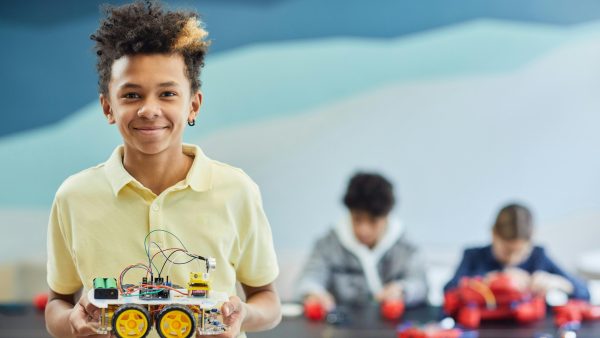We have two different ways for machines to learn. And, on many occasions, they work together. To fully understand unsupervised learning, it is a priority to shed light on supervised learning.
What is supervised learning and how does it work? Practical examples
Imagine that a computer is learning to identify animals. Through supervised learning, it receives previously labelled images. In this way, the computer will know when a monkey is a monkey, and not a dog, because of its physical characteristics. Or, for example, if it needs to identify different types of fruit. A banana is not the same as an apple, or a kiwi: the banana is long, yellow, and has black speckles (if it is from the Canary Islands, of course), and the apple is rather spherical in shape. This prior labelling is known as input data.
Supervised learning, in turn, is divided into two different types: classification and regression:
- Supervised learning by classification: the algorithm uses the input data to classify the elements. Once it recognises what a pear is thanks to the labelling, subsequent pears will be recognised and classified as such. The result we get is a class, a category, among many possible ones.
- Regression supervised learning: This time, the result obtained will not be a class, but a number: the computer will predict a numerical value with a relation between several input variables and one output variable. Imagine you work in an online study platform and you want to predict the scores that students will get in an exam. To do this, you have valuable information at your disposal: the study hours of former students and their final exam score. In this sense, supervised regression learning will calculate the possible score of new students based on the study time of the new students.
- Machine learning can also be useful for detecting hoaxes and fake news. For example, through Google’s reverse image search (i.e. instead of searching for a word, we upload an image and it gives us a certain result) we can see if the photo on the front page corresponds to that news.
To detect a fake video, you can extract stills and then perform a reverse search. Alan Bursztyn, a student of Information Systems Engineering at the Buenos Aires Regional Faculty of the National Technological University, in an article on LinkedIn, explains how, thanks to machine learning, they managed to detect a video in which an orangutan was washing its hands during the pandemic, as if it were imitating humans, as a fake. Thanks to the image they extracted and the reverse search, they found that there were already news reports on Google claiming that the video was fake.
What is unsupervised learning and how does it work?
Now that we are clear on what supervised learning is, let’s take a closer look at unsupervised learning. In unsupervised learning, there are no pre-existing labels. The system, on its own, tries to locate patterns or relationships between data on its own. For example, if the computer has images of dogs and cats with no prior data, its algorithm is unable to identify the characteristics of those images. What it does, therefore, is to group them according to the similarities it finds between them.
Ultimately, the primary goal of unsupervised learning is to study the structure of the data, which often remains hidden.
Unsupervised learning is achieved through different rules, which are explained below.
- Clustering rules. This is one of the most common techniques in unsupervised learning. The aim is to find natural groups in the data without prior information on how to group them. Take an online shop as an example: thanks to clustering, different categories of customers with similar buying patterns can be identified. This is very suitable for personalised advertising strategies, for example.
- Association rules. Thanks to the association technique, the algorithm is able to find out what relationships exist between different variables in a large database. An example of this technique is applied, according to experts such as IBM, in sections of online shops in which a list of certain items is recommended according to the previous consumption of who is on the page. Or, for example, Spotify’s weekly discovery list. To achieve these association rules, machine learning uses different algorithms: the most common is the Apriori algorithm. This algorithm detects frequent patterns to “identify the probability of consuming a product given the consumption of another product”. For example, if we listen to a heavy song, the next song is likely to be of the same genre.
- Dimensionality reduction. This technique is used when the number of features is very large. Several methods are used, such as principal component analysis (PCA), which reduces the dimensionality of features while preserving as much valuable information as possible. Imagine, for example, that you have a series of handwritten numbers from 0 to 9. Each image is composed of different pixels: this already reveals a high dimensionality. If each image is 28×28, this would give us a total of 784 features (pixels) per image. Principal component analysis takes these 784 features and creates new super features called principal components.
Unsupervised learning applications
- Google News already uses unsupervised learning to establish different categories of news stories and group them according to their subject matter.
- Detecting anomalies and irregularities within a massive dataset.
- Customer buying habits for personalised advertising
- Recommendations of movies or songs that a subscriber may like
- Object recognition
- Assisting the medical sector in basic imaging device functions










